Suaeda calceoliformis (Seablite)
| Also known as: | American Seablite, Pursh's Seepweed, Horned Seepweed |
|---|---|
| Genus: | Suaeda |
| Family: | Amaranthaceae (Amaranth) |
| Life cycle: | annual |
| Origin: | native |
| Habitat: | sun; saline or alkaline soil; marshes, shores, prairie swales, salted roadsides |
| Bloom season: | June - September |
| Plant height: | 3 to 30 inches |
| Wetland Indicator Status: | GP: FACW MW: FACW NCNE: FACW |
| MN county distribution (click map to enlarge): |  |
| National distribution (click map to enlarge): |  |
Pick an image for a larger view. See the glossary for icon descriptions.
Detailed Information
Flower: 

![[photo of flower clusters]](/udata/r9ndp23q/pd/suaeda-calceoliformis-72316-5-t.jpg) Tiny flowers are tightly packed in small clusters (glomes) in a spike-like arrangement at the top of the stem and arising from leaf axils, with 3 to 5 flowers in a cluster. Flowers are up to 1/6 inch diameter (1 to 4 mm), lack petals, have 2 short stamens and a round, green ovary with a 2-parted style at the tip.
Tiny flowers are tightly packed in small clusters (glomes) in a spike-like arrangement at the top of the stem and arising from leaf axils, with 3 to 5 flowers in a cluster. Flowers are up to 1/6 inch diameter (1 to 4 mm), lack petals, have 2 short stamens and a round, green ovary with a 2-parted style at the tip.
![[close-up of glomes]](/udata/r9ndp23q/pd/suaeda-calceoliformis-75938-18-t.jpg) Cupping the flower is a green calyx with 5 fleshy, somewhat angular lobes each with 1 or 2 horn-like extensions at the tip; at least one lobe is usually larger than the others. At the base of a glome is a leaf-like bract up to ½ inch long that has thin, translucent edging near the base. The calyx, stalks and bracts are all smooth and hairless.
Cupping the flower is a green calyx with 5 fleshy, somewhat angular lobes each with 1 or 2 horn-like extensions at the tip; at least one lobe is usually larger than the others. At the base of a glome is a leaf-like bract up to ½ inch long that has thin, translucent edging near the base. The calyx, stalks and bracts are all smooth and hairless.
Leaves and stems: 

![[photo of leaves]](/udata/r9ndp23q/pd/suaeda-calceoliformis-72613-4-t.jpg) Leaves are alternate, fleshy, mostly ascending to nearly erect, 3/8 to 1½ inches long, hairless, toothless, stalkless, lance-linear, pointed or with a small, whitish, abrupt point at the tip. Stems are erect to sprawling, usually branched, hairless, often striped red and green, and have a waxy coating. Plants are initially green but often turn dark red all over, or spotted with dark red.
Leaves are alternate, fleshy, mostly ascending to nearly erect, 3/8 to 1½ inches long, hairless, toothless, stalkless, lance-linear, pointed or with a small, whitish, abrupt point at the tip. Stems are erect to sprawling, usually branched, hairless, often striped red and green, and have a waxy coating. Plants are initially green but often turn dark red all over, or spotted with dark red.
Fruit: 
![[photo of developing fruit]](/udata/r9ndp23q/pd/suaeda-calceoliformis-815-11-t.jpg) Fruit is a dry seed enclosed in the persistent ovary shell (pericarp) that easily separates from the seed. Seeds are flattened round to egg-shaped, .8 to 1.7 mm long, shiny black or dull brown.
Fruit is a dry seed enclosed in the persistent ovary shell (pericarp) that easily separates from the seed. Seeds are flattened round to egg-shaped, .8 to 1.7 mm long, shiny black or dull brown.
Notes:
Seablite is an uncommon species of saline and alkaline soils in our western counties, most often in wet-mesic prairies and prairie swales but is known to inhabit salted roadsides as well, which is where it was found in St. Louis County. It is considered rare in the salt marshes of coastal New England but is more common to our west. Where it is encountered it often forms large mats that turn dark red, much like the rare Red Saltwort (Salicornia rubra), with which it may grow, but which has scale-like leaves that overlap like a cedar branch.
Native Plant Nurseries, Restoration and Landscaping Services ↓
More photos
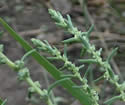 Seablite plant
Seablite plant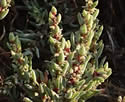 Seablite plants
Seablite plants Seablite plants
Seablite plants Seablite plants
Seablite plants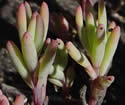 young plants
young plants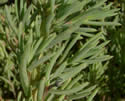 leafy stem
leafy stem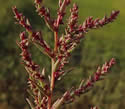 plants are often red
plants are often red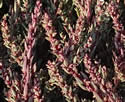 a mat of Seablite
a mat of Seablite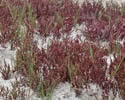 Seablite habitat
Seablite habitat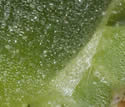 bracts have thin, translucent edging at the base
bracts have thin, translucent edging at the base
Photos by K. Chayka taken in North Dakota. Photos by Peter M. Dziuk taken in Kittson and Lac Qui Parle counties and in North Dakota.
Comments
Have you seen this plant in Minnesota, or have any other comments about it?






